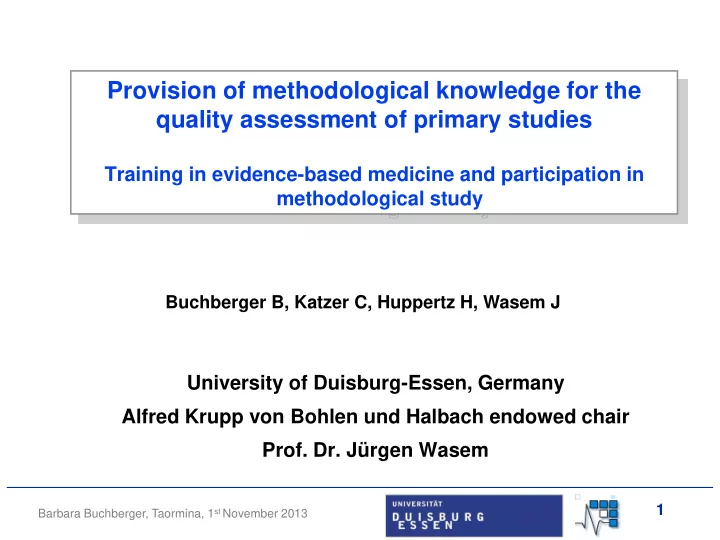

Provision of methodological knowledge for the quality assessment of primary studies Training in evidence-based medicine and participation in methodological study Buchberger B, Katzer C, Huppertz H, Wasem J University of Duisburg-Essen, Germany Alfred Krupp von Bohlen und Halbach endowed chair Prof. Dr. Jürgen Wasem 1 Barbara Buchberger, Taormina, 1 st November 2013
Advertisement Once only in winter semester 2011/12: training in evidence- based medicine and participation in a methodological study instead of exercises and homework (3 ETCS) The examination attainment will be delivered in the last session, consisting of the quality assessment of studies by different instruments after being trained in evidence-based medicine. Participation in all sessions is absolutely necessary for the data evaluation and analysis, the success of the study, and therefore highly desirable and obligatory. In case of illness, a medical certificate is required. 2 Barbara Buchberger, Taormina, 1 st November 2013
Dates, Contents 23.11.2011: 14.00-16.00 o‘clock SE005 Theoretical provision of essential terms of EbM and quality criteria, validity assessment of 1 study 18.01.2012: 12.00-16.00 o‘clock SM205 Deepening of the knowledge by simulation of quality aspects, poster presentation, quizz, introduction of assessment instruments, application training 25.01.2012: 14.00-16.00 o‘clock SE005 Execution of the methodological study Participation in all sessions is absolutely necessary for the data evaluation and analysis, the success of the study, and therefore highly desirable. 3 Barbara Buchberger, Taormina, 1 st November 2013
Structure of the first session I/III The concept of evidence-based medicine: the five steps 1. Formulating a well-built question - PICO-scheme, example patient from everyday clinical practice 2. Literature research - Types of primary and secondary studies, MeSH-terms/Boolean operators, example study as a research result 3. Critical appraisal - Validity (internal, external), classification of evidence (G-BA*, AHRQ**), single aspects, assessment of example study 4. Application of results in practice - example patient, example study 5. Evaluation * Gemeinsamer Bundesausschuss = Federal Joint Committee ** Agency for Healthcare Research & Quality 4 Barbara Buchberger, Taormina, 1 st November 2013
Structure of the first session II/III Criteria for the quality assessment Randomisation (single, permuted, cluster, inadequate) Concealment Blinding Schulz & Grimes. Lancet 2002; 359:614-618 The authors: double blinded versus single blinded . Lancet 2002; 359: 696 – 700 Drop-out/loss to follow-up ITT (mnemonic : „ Once randomised, always analysed “) Sample size calculation (outcome criterion, effect size expected, statistical power, type I-error/level of significance, sample size determined) 5 Barbara Buchberger, Taormina, 1 st November 2013
Structure of the first session III/III Criteria for the quality assessment Sponsoring Bias and its prevention: Selection (Reporting, Publication), Performance, Detection, Attrition, Language, Recall, Citation, Healthy-user, Confirmation Assessment of example study Limits of evidence-based medicine and criticism 6 Barbara Buchberger, Taormina, 1 st November 2013
Structure of the second session Introduction: Stratification, Reliability/Validity Poster presentation Randomisation; concealment; blinding; drop-out, loss to follow- up; ITT- and per-protocol analysis; sample size calculation, confidence intervals, p-values; types of bias Simulation of randomisation, blinding, concealment, drop-out, loss to follow-up, ITT Introduction of assessment instruments Application training Verbal quizz between two teams with hangman 7 Barbara Buchberger, Taormina, 1 st November 2013
Simulation of Randomisation, Blinding, Concealment, Drop-out, ITT Random number table in a sealed, opaque envelope Prepared dextrose cubes with numbers written on: Blinding of treatment allocation Stratification By sex By age groups < 25 years and ≥ 25 years 8 Barbara Buchberger, Taormina, 1 st November 2013
Unblinding (sealed opaque envelope with random number table) Participant 1 2 3 4 5 6 7 8 9 10 11 12 13 14 15 16 Random number 8 1 2 9 2 7 3 6 2 4 5 3 5 7 7 8 Participant 17 18 19 20 21 22 23 24 25 26 27 28 29 30 31 32 Random number 0 0 9 3 0 9 6 0 7 0 5 5 9 0 2 3 Participant 33 34 35 36 37 38 39 40 41 42 43 44 45 46 47 48 Random number 1 9 2 0 6 2 5 1 0 7 2 1 0 5 2 8 Intervention : 0-4 Control: 5-9 9 Barbara Buchberger, Taormina, 1 st November 2013
Participants in the study course 1 2 3 4 5 6 7 8 9 10 11 12 13 14 15 16 17 18 19 20 21 22 23 24 25 26 27 28 29 30 31 32 33 34 35 36 37 38 39 40 41 42 43 44 45 46 47 48 49 50 Crossover Loss to follow-up Drop-out Control Intervention 10 Barbara Buchberger, Taormina, 1 st November 2013
Populations for analyses Intention-to-treat population: n=47 Intervention Intervention: n= 27 Control vs. control: n= 20 Crossover Drop-out Loss to follow-up Per-protocol population Intervention: n= 14 (- 8 crossover- 4 drop-out- 1 loss to follow-up) vs. control: n= 14 (-2 drop-out- 4 loss to follow-up) As-treated population Intervention: n= 14 (- 8 crossover- 4 drop-out- 1 loss to follow-up) vs. control: n= 22 (+ 8 crossover- 2 drop-out- 4 loss to follow-up) 11 Barbara Buchberger, Taormina, 1 st November 2013
Quality assessment instruments Julian Higgins Jürgen Windeler Catherine L. Hill Peter Jüni Helen Thomas Higgins JPT , Green S. Cochrane Handbook for Systematic Reviews of Interventions 5.1.0. Oxford, UK: The Cochrane Collaboration; 2011 Hill CL , La Valley MP, Felson DT. Arthritis and Rheumatism 2002; 46(3): 779-84. Huwiler-Müntener K, Jüni P , Junker C, Egger M. JAMA 2002; 287(21): 2801-2804. IQWiG 2008. Früherkennungsuntersuchung von Sehstörungen bei Kindern bis zur Vollendung des 6. Lebensjahres. Abschlussbericht 2008. Köln, IQWiG-Berichte, Nr. 32. Thomas BH , Ciliska D, Dobbins M, Micucci S. Worldviews on evidence-based nursing 2004; 1(3): 176-184. 12 Barbara Buchberger, Taormina, 1 st November 2013
Cochrane risk of bias tool 13 Barbara Buchberger, Taormina, 1 st November 2013
Thank you for your attention Correspondence to: Dr. Barbara Buchberger, MPH University of Duisburg-Essen Institute for Health Care Management and Research Schützenbahn 70 45127 Essen, Germany Phone: +49 (201)183 4075 Fax: +49 (201)183 4073 E-Mail: barbara.buchberger@medman.uni-due.de 14 Barbara Buchberger, Taormina, 1 st November 2013
Recommend
More recommend